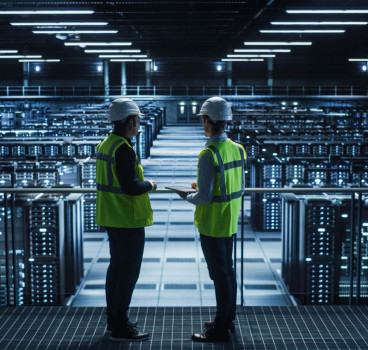Bricks and brilliance - building a booming India
India, a land of bustling cities and serene villages, is in the midst of a monumental construction boom. From soaring skyscrapers gracing skylines to intricate highways crisscrossing the landscape, the Indian construction industry is driving economic growth and shaping the nation's future. With a market size predicted to reach $1.4 trillion by 2025, according to Invest India, the opportunities for architects, builders, and construction professionals are as vast as the country itself, writes John Ridgeway.
India's construction landscape isn't just a booming marketplace; it's a canvas primed for architectural and engineering brilliance. While the market size and diverse sectors paint a promising picture, a deeper investigation reveals even richer layers of opportunity and challenges waiting to be tackled.
The Indian construction boom isn't merely about piling bricks - it's about pioneering new frontiers. Automation and robotics are transforming construction sites, with drones surveying landscapes and 3D printing revolutionising building processes. Prefabricated modules are streamlining timelines and minimising on-site disruption, while technology platforms connect stakeholders and optimise project management.
It would also seem that India's rapid urbanisation is not coming at the cost of environmental degradation. The demand for green construction practices is also soaring, with developers seeking eco-friendly materials, energy-efficient solutions, and renewable energy integration.
While cities steal the spotlight, the true potential of Indian construction lies in building for everyone. Tier-2 and -3 cities are offering vast opportunities for affordable housing projects, rural infrastructure development, and community-driven initiatives.
This is being led by India's ambitious Smart Cities Mission, which aims to revitalise 100 cities across the country, transforming them into urban hubs of sustainability, technology, and efficiency. This ambitious initiative boasts significant implications for the construction industry, presenting exciting opportunities and demanding innovative approaches.
The development of smart cities has necessitated the integration of modern construction practices and technologies, particularly the need for sustainable infrastructure.
India’s smart cities prioritise clean energy solutions, waste management systems, and green buildings. This opens doors for architects and builders specialising in energy-efficient materials, renewable energy integration, and sustainable construction techniques.
Smart cities rely heavily on data sensors and digital infrastructure, requiring construction materials and techniques compatible with these technologies. Building Information Modelling (BIM) and other digital tools are playing a crucial role in designing and managing smart infrastructure projects.
High-performance materials with self-cleaning, thermal insulation, and self-repairing properties, are also in high demand, helping to create a resilient and low-maintenance smart city infrastructure.
While the potential is vast, several challenges still need to be addressed. The Indian construction industry for example, like much of the rest of the world, needs to bridge the gap in skills such as data analysis, automation, and smart technology integration. Skill development programmes and training initiatives are crucial to equip the workforce for the smart city era.
This potential is being realised by the Indian government's ambitious National Infrastructure Pipeline (NIP) with an investment of $1.4 trillion over five years (Invest India, 2023) which will inject substantial resources into highways, railways, urban infrastructure, and renewable energy projects.
This is matched by a booming real estate sector, with residential and commercial projects mushrooming across the country, catering to a growing middle class and foreign investors.
Within this diverse landscape, there are other specific sectors, which offer exciting opportunities for architects and builders, such as residential construction. As urbanisation surges, affordable housing projects, smart homes, and luxury apartment complexes present lucrative opportunities.
Booming businesses in India are demanding more office spaces, consumers want more shopping malls and hotels, all requiring innovative and sustainable design solutions.
The NIP focuses on roads, railways, airports, and renewable energy plants, creating massive potential for infrastructure specialists. As already discussed, sustainability also takes centre stage, with rising demand for energy-efficient buildings, waste management systems, and green materials.
Despite such prospects, Indian architects and builders face significant challenges. We have already highlighted labour shortages, but construction professionals are also faced with navigating complex regulatory frameworks and obtaining approvals, which can lead to delays and cost overruns (Source World Bank, 2020).
Ensuring quality construction and worker safety also remains a crucial challenge, requiring stricter regulations and enforcement (Source: National Safety Council of India, 2023).
That said, action is being taken to address these issues. We can see more investment in vocational training programmes and skill development initiatives to equip the workforce with the necessary expertise.
Simplifying regulatory processes and digitising permits are helping to expedite project timelines and attract investments. We are also seeing new stringent quality control measures, helping to enforce strong safety protocols that can safeguard both workers and project outcomes.
So, we can see that the Indian construction industry is at a pivotal juncture, brimming with opportunities but also facing pressing challenges. The Indian construction boom is more than just an economic surge, it's an opportunity to reshape the nation's landscape, infrastructure and future.
By embracing innovation, prioritising sustainability, building inclusively, upskilling the workforce, fostering collaboration, and ensuring worker safety, Indian architects and builders are transforming this boom into a catalyst for lasting progress
Further Information:
- Invest India: https://www.investindia.gov.in/sector/construction
- McKinsey Global Institute: https://www.mckinsey.com/featured-insights/urbanization/urban-awakening-in-india
- FICCI: https://www.ffcccii.org/
- World Bank: https://archive.doingbusiness.org/en/data/exploreeconomies/india
- National Safety Council of India: https://nsc.org.in/
- Centre for Science and Environment: https://www.cseindia.org/
Additional Blogs

What if Building Control went fully digital?
Building control governs structural integrity, fire protection, energy efficiency, accessibility and countless other aspects of design and construction. Historically, this process has been highly...
Read moreWhere most “Smart Buildings” go wrong
Smart buildings are often presented as the ultimate in modern construction - interconnected, efficient, intuitive and driven by real-time data. They promise lower operating costs, reduced energy use,...
Read more

The future of facilities management starts at RIBA Stage 0
Facilities management has traditionally been treated as a discipline that only becomes relevant once a building is handed over. At that point, FM professionals inherit decisions made months or years...
Read more